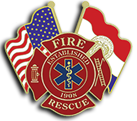The STARS program helps coordinate and coach ambulance districts, fire districts and community hospitals to:
- Recognize the special needs of patients inside their coverage area
- Undergo the appropriate, specialized training to care for these patients’ special medical needs
 Children who especially benefit are those with:
Children who especially benefit are those with:
- a tracheostomy
- ventilator dependent
- severe osteogenesis imperfecta
- severe bleeding disorders
- certain endocrine disorders
- unrepaired cardiac anomalies
- a known history of prolonged or refractory status epilepticus
- mitochondrial and metabolic disorders
- atypical diseases or syndromes
- Nonverbal with known elopement risks or behavioral challenges that may require physical or chemical restraint
- a DNR or POLST
How STARS works
The fire or ambulance district will appoint a STARS coordinator and determine a point of contact for families.

Fire and ambulance districts are no longer doing the home visits with the patients. They are being conducted by the SSM Health Cardinal Glennon STARS Program personnel. They then enter that patients pertinent medical information into a secured database (which the STARS liaisons have the ability to update or change the plan as needed). Over 2020 STARS transferred from their paper-copy binders to an online/mobile database where we are now sent, via text message, the patient “pre-plans” or “medical information” directly to our truck phones when a call goes out. The idea is for us to receive the link while in route to the call so that it is ready and in hand when we arrive on scene. To help ensure the patient’s privacy the secured link that is dispatched to our phones is only accessible until the call is closed, however, we can use our personal log-in to get into the database at any time. This is utilized during training to help us provide the proper care when it is most needed.
All of the STARS children are still given an identifying number; however, they have updated that as well. They used to be given numbers with some type of district identifier. For example, children who lived within our district would be given numbers such as, 35-01, 35-02, 35-03, etc. Now, they have moved to a simpler system where it is no longer district specific. The number identifiers now read from 1-1128 with no specific district designation. This helps with kids who may be traveling through our area from other areas. The families provide dispatch what the patient’s number identifier is and we will be dispatched that pre-plan. We can also search the database by name which helps too!
Special advanced training and education is then provided by SSM Cardinal Glennon for the ambulance district, fire department and/or the community hospital. Pre-plans are then set to match the anticipated needs of the “star” child for those emergency or hospitalization situations.
How STARS is successful
The STARS program works best if the most current pre-plan is in the hands of the first responders and local hospital so they may reference it prior to seeing the child.
Regular contact between caregivers and first responders for updates on medical changes is imperative. When changes are made, information should be shared with all parties involved, following—of course—the rules and regulations for “flagging” an address and passing private health information from one caregiver to another.
STARS was created by experienced first responders and training is coordinated through and provided by SSM Cardinal Glennon and/or St. Louis Children’s Hospital, where experienced staff are acutely aware of the capabilities and limitations of first responders and community hospitals. Thus, making the relationship one of mutual benefit
